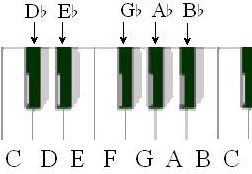

|
Thanks for subscribing and welcome to: A Player's Guide Newsletter issue #03 --- the Pentatonic Scale What's InsidePentatonic ScalesNow, moving on from the last issue of this newsletter, let's finish up "scales" with a very popular, fun scale, the pentatonic scale. Pentatonic ScalesThe pentatonic scale is arguably one of the most widely used scales in music. It can be found in just about all ancient and contemporary cultures, including Celtic folk music, Hungarian folk music, African-American spirituals, Gospel music, American folk music, Jazz, American blues music, rock music and many more.The pentatonic is a 5 note scale as opposed to the more traditional major and minor scales, which contain all 7 notes of the musical alphabet (or the 12 note chromatic scale.) Pentatonic scales are closely related to the traditional major and minor scales. They can also be major or minor. Major Pentatonic ScalesMajor pentatonic scales are basically major scales without the 4th and 7th scale steps: 1-2-3-5-6-(8-1) So a C major pentatonic would be: C-D-E-G-A-CHere is a C major scale and a C major pentatonic scale:
Here are some other major pentatonic scales:
Minor Pentatonic ScalesThe minor pentatonic scale is basically the natural minor scale minus the 2nd and 6th scale steps.Here are the C natural minor scale and C minor pentatonic scale:
This is an ideal, straightforward scale for blues improvisation. The Blues ScaleThe Blues Scale is a seven note scale that is primarily used in jazz, blues and rock. This scale has notes that are called "blue" notes. They are played (or sung) lower, or flat. These notes ore the 3rd and the 7th.The seven scale notes are:
In the key of C this would be C-Eb-F-Gb (or F#)-G-Bb-C.
BLUES SCALE - 12 BAR BLUES - PENTATONIC SCALES
So, that's it for now. Stay tuned for Newsletter issue# 04:
the next stop on our ROAD MAP! This will follow around the 1st of the month! Thanks, and enjoy the website!
Copyright © 2011 Ralph Martino New! CommentsPlease leave me a comment in the box below. |
Fill out the form below to sign up for updates and the free monthly
Player's Guide Newsletter!
Get tips and ideas about substitute chords, chord progressions and harmonic movement.







